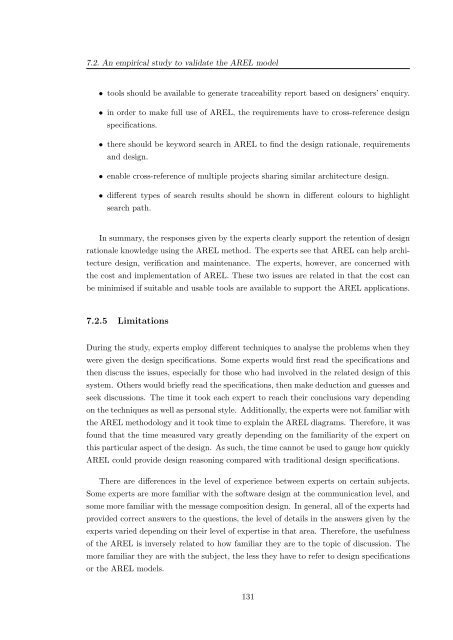A Rationale-based Model for Architecture Design Reasoning
A Rationale-based Model for Architecture Design Reasoning
A Rationale-based Model for Architecture Design Reasoning
You also want an ePaper? Increase the reach of your titles
YUMPU automatically turns print PDFs into web optimized ePapers that Google loves.
7.2. An empirical study to validate the AREL model<br />
• tools should be available to generate traceability report <strong>based</strong> on designers’ enquiry.<br />
• in order to make full use of AREL, the requirements have to cross-reference design<br />
specifications.<br />
• there should be keyword search in AREL to find the design rationale, requirements<br />
and design.<br />
• enable cross-reference of multiple projects sharing similar architecture design.<br />
• different types of search results should be shown in different colours to highlight<br />
search path.<br />
In summary, the responses given by the experts clearly support the retention of design<br />
rationale knowledge using the AREL method. The experts see that AREL can help architecture<br />
design, verification and maintenance. The experts, however, are concerned with<br />
the cost and implementation of AREL. These two issues are related in that the cost can<br />
be minimised if suitable and usable tools are available to support the AREL applications.<br />
7.2.5 Limitations<br />
During the study, experts employ different techniques to analyse the problems when they<br />
were given the design specifications. Some experts would first read the specifications and<br />
then discuss the issues, especially <strong>for</strong> those who had involved in the related design of this<br />
system. Others would briefly read the specifications, then make deduction and guesses and<br />
seek discussions. The time it took each expert to reach their conclusions vary depending<br />
on the techniques as well as personal style. Additionally, the experts were not familiar with<br />
the AREL methodology and it took time to explain the AREL diagrams. There<strong>for</strong>e, it was<br />
found that the time measured vary greatly depending on the familiarity of the expert on<br />
this particular aspect of the design. As such, the time cannot be used to gauge how quickly<br />
AREL could provide design reasoning compared with traditional design specifications.<br />
There are differences in the level of experience between experts on certain subjects.<br />
Some experts are more familiar with the software design at the communication level, and<br />
some more familiar with the message composition design. In general, all of the experts had<br />
provided correct answers to the questions, the level of details in the answers given by the<br />
experts varied depending on their level of expertise in that area. There<strong>for</strong>e, the usefulness<br />
of the AREL is inversely related to how familiar they are to the topic of discussion. The<br />
more familiar they are with the subject, the less they have to refer to design specifications<br />
or the AREL models.<br />
131
















